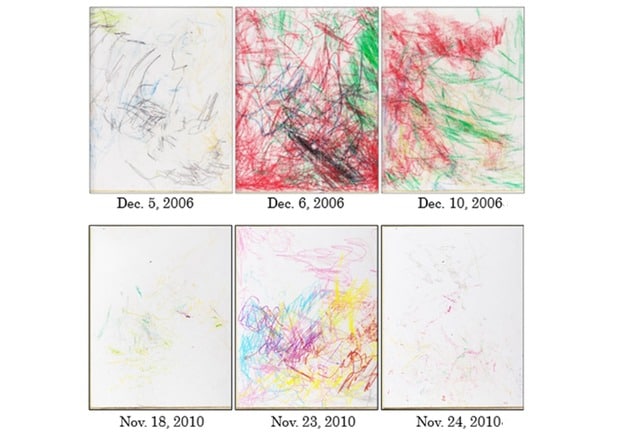Scientists have shown for the first time that non-human primates can have an individual style of drawing that, in some cases, evolves over the course of life. After analyzing 790 drawings created by Kalimantan orangutans from the Japanese Tama Zoo, the researchers found noticeable differences between the creativity of different individuals in terms of composition, choice of colors and the shape of the objects depicted. And for the female Molly, who was a particularly prolific artist, her painting style changed over time – including the season. The research results were published in an article for the journal Animals.
Monkeys living in zoos and research centers are often fond of drawing. Realistic painting is not available to them, but they are happy to create bright abstract canvases – even if they do not receive any reward for it. Drawing lessons can significantly diversify the leisure of primates. They are also useful for scientists who are trying to find the evolutionary origins of the visual arts.
Tama Zoo in Tokyo is one of the places where painting of nonhuman primates is especially actively studied. The Kalimantan orangutans (Pongo pygmaeus) kept here are regularly painted on cardboard with crayons under the supervision of caretakers. Particular success in painting was demonstrated by a local female named Molly (1952-2011), who created about 1300 works in the last five years of her life.
A team of researchers led by Marie Pelé from the Catholic University of Lille decided to find out if orangutan artists have an individual style and if it changes over time. To do this, scientists collected and analyzed 749 drawings created by five females (Molly, Kiki, Gypsy, Julie and Yuki) from Tama Zoo from 2006 to 2016. 656 of them belonged to Molly. Molly’s work had previously attracted the attention of scientists: for example, several years ago it turned out that events in the life of this female and the personality of the caretaker who was next to her influenced what colors she chose and how she would place objects on paper (for example, after giving birth to other Molly females used red more often.
By breaking down each drawing into 100 cells, Pele and her colleagues found that orangutans filled in about half of them with strokes. 20 percent of the cells had overlapping strokes of different colors, and 10 percent of the cells had more than half of the same color. On average, primates used three colors per pattern, and among geometric shapes they preferred patterns resembling fans and loops (each figure contained 1.8 and 0.7 such objects, respectively).
Analysis showed that Molly’s drawing style was markedly different from that of other orangutans from Tama. She used more colors, filled in and painted more cells, and placed strokes closer to the center. In addition, her drawings were less contrasting as she pressed lightly on the crayon. Interestingly, the orangutans liked different colors: Molly and Kiki preferred green, while Gypsy, Julie and Yuki preferred red.
The authors note that of all the females, Molly created the most complex drawings. She was followed by Yuki – but Kiki’s images were simple, but bright (unlike Molly, she pressed hard on the chalk). Probably, the peculiarities of the style were associated with the individual character traits of the orangutans and their life experience. So, Molly was born in the wild, lived in two zoos and gave birth to offspring four times. For comparison, Kiki was born in captivity, almost immediately ended up in Tama Zoo and gave birth to one cub here.
Because Molly left behind a particularly large number of drawings, Pele and co-authors were able to establish how her style has evolved. It turned out that in different seasons the female painted a little differently. For example, in the winter months, she filled in a much smaller proportion of the cells with strokes. Perhaps due to the cold weather and the lack of visitors in winter, she wanted to paint less than usual. And in the spring, she used purple as the main color much more often (in 23.4 percent of cases). The female’s drawing style has also changed over the course of five years. Towards the end of her life, Molly began to use fewer colors and fill a smaller proportion of the cells on the sheet, and also increasingly moved away from the center. Perhaps the reason for these changes was partly due to health problems; in particular, the female was blinded in her left eye. However, she continued to create much more complex designs than the other four orangutans from Tama.
Pele and her colleagues admit that the orangutan creations were sometimes difficult to interpret because the paper was splashed with dirt – or because primates started a new design over an old one. In addition, the sample consisted of only five individuals of the same sex. However, for the first time, the authors were able to demonstrate that non-human primates can have an individual drawing style that evolves over time.
The passion of our ancestors for painting also began with abstract images. This is indicated by the oldest known pattern – a hashtag-like pattern that was made with ocher on a piece of stone about 73 thousand years ago.
Photo: Examples of Molly’s drawings. The center and right illustrations in the top row were created after another female orangutan from Tama Zoo gave birth to a baby. Yuki Hanazuka et al. / Frontiers in Psychology, 2019









